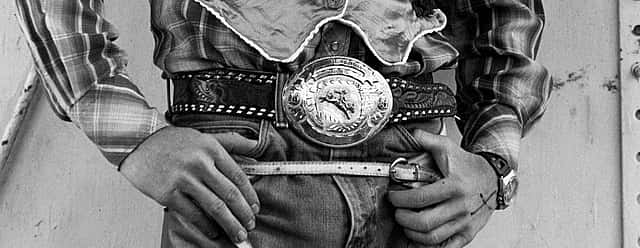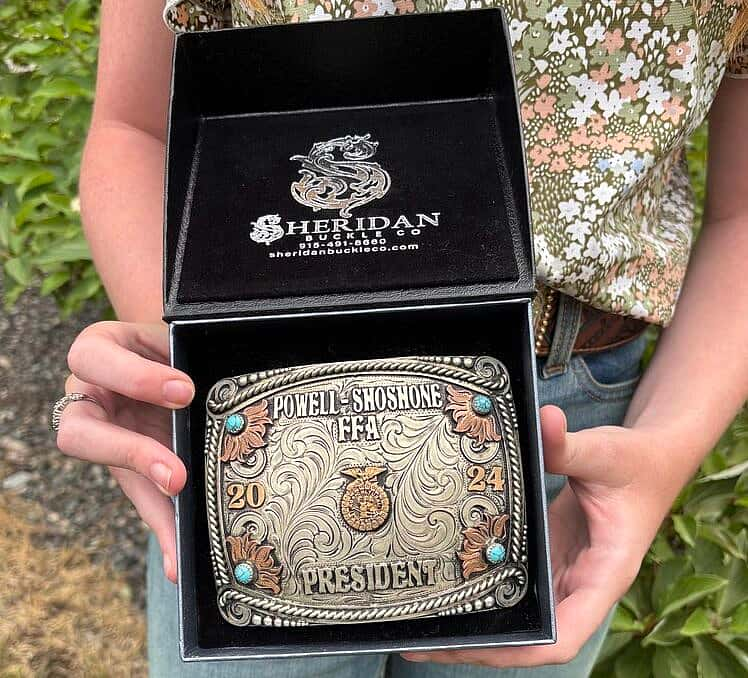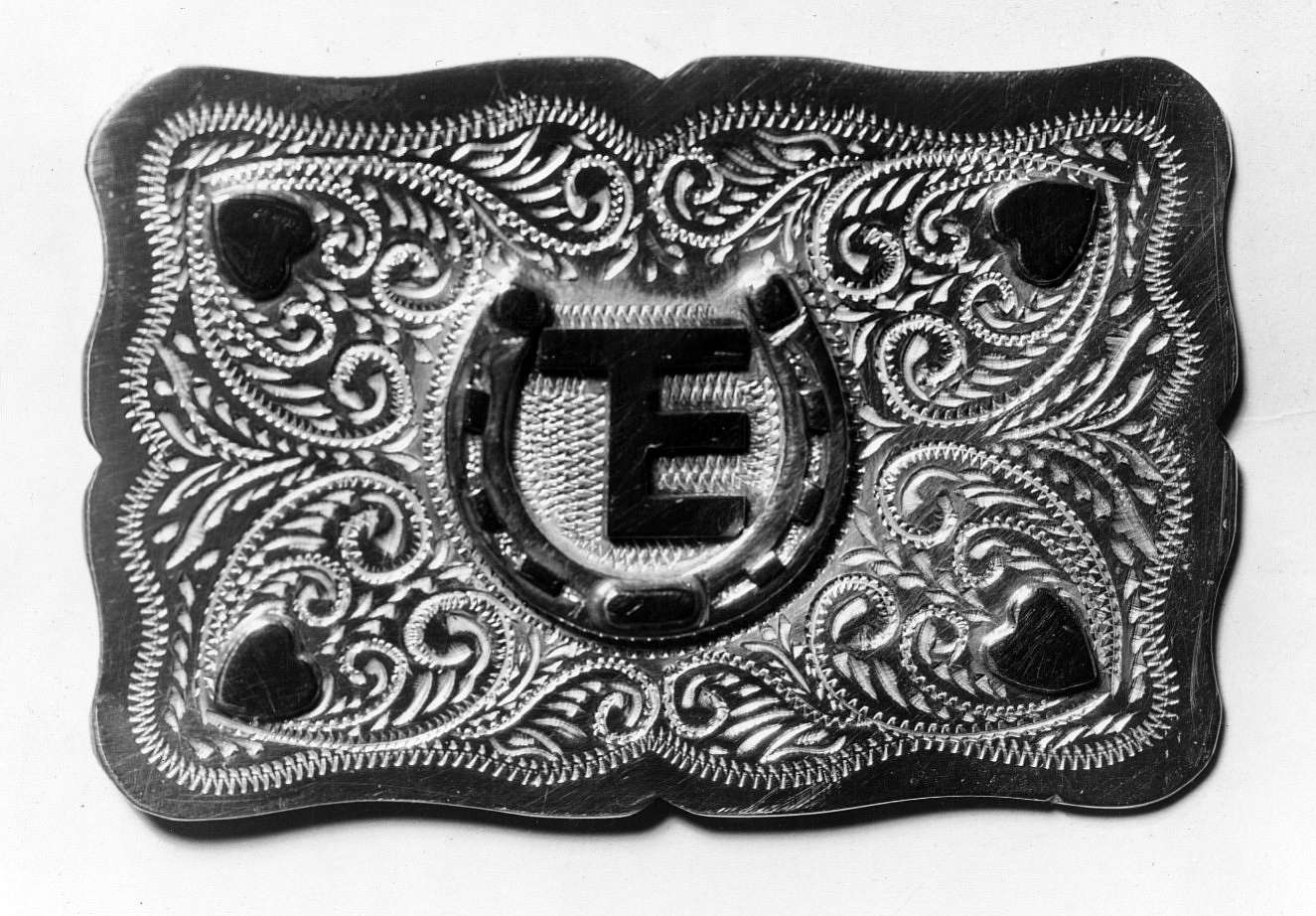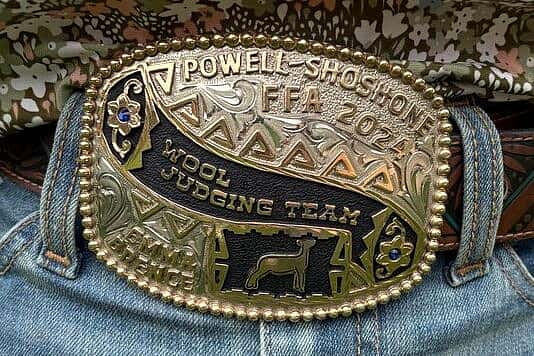
Buckle Up, Cowboy: How the Western Belt Buckle Became an Icon
Buckle-Obsessed
When we were thinking of thematic sections for our upcoming Spur of the Moment western fashion exhibition, one thing kept coming to mind: belt buckles. More specifically, I kept thinking about trophy buckles like the ones I’d been seeing all summer.

The 2025 PR intern rocked an oversized, turquoise-studded statement buckle all summer like it was her personal badge of honor. The buckle is more than just a functional piece holding up her jeans. It anchors her entire outfit, pulling together fashion and function in a way that’s both effortlessly classy and exudes Western charm. It only took a week for me to realize that her buckles aren’t supporting accessories; they’re the star of the show, every single day. I couldn’t stop admiring them.
Then came the Cody Nite Rodeo buckle awards. Every night the champions are awarded trophy buckles to commemorate their victories. These aren’t your average belt buckles. We’re talking about works of art, engraved with intricate detail, the Cody Nite Rodeo logo front and center, the event title gleaming, and the year immortalized in the material. Rodeo contestants fight for these buckles. They show up night after night, all summer long, for a chance to walk away as champions with the buckle to prove it. It’s not just a prize; it’s a legacy of accomplishment clasped around their waist.
And if that wasn’t enough to make me buckle-obsessed, along came the Cheynne Frontier Days Annual Chuckwagon Cook-Off. Picture this: the best chuckwagon chefs cooking over open flames, battling for culinary glory. What does the overall champion win? Well, sure, there’s a cash prize, but the real trophy? A belt buckle. A big, gleaming, silver showstopper, with the Cheyenne Frontier Days logo engraved right in the heart of it. You can spot it from miles away. It demands attention. But more than that, it represents hard work, dedication, and the sheer pride in winning a meaningful competition . What’s more western than that?
History of the Western Belt Buckle: From Function to Fashion
Long before they were shining symbols of western pride, belt buckles were purely practical. Ancient civilizations used metal buckles to fasten armor and secure clothing, making buckles purely functional pieces that were built to hold things together, not turn heads. Over time, metalworking evolved, and so did the buckle. By the 17th and 18th centuries, buckles had become decorative pieces in European fashion, often made of silver or brass and engraved to signal wealth and status.

The story of the western belt buckle starts much later, and much further west. Buckles arrived in the American West through the cavalry, whose gear and uniforms relied on sturdy metal fasteners. Early cowboys borrowed that durable hardware style, using simple and practical buckles for their belts and saddles. These buckles weren’t flashy in the slightest; they were simply solid, reliable pieces designed to survive hard riding, dust, and work on the range.
Everything changed when Hollywood came calling in the 1920s and 1930s. Western films turned cowboys into icons, and costume designers began leaning into that image. They added engraved silver buckles, hand-tooled leather, and oversized designs that looked great on camera to stage costumes. The influence was undeniable, and a western buckle boom occurred. What had once been a simple workman’s tool was now a fashion statement.
By the 1940s and 1950s, the belt buckle had fully earned its place in Western identity thanks in large part to the rise of rodeo culture in the 1920s. Winners in events like bull riding and barrel racing began receiving trophy buckles in place of ribbons or medals. These trophy buckles were wearable symbols of skill, pride, and status. Companies like Bohlin transformed buckles into wearable works of art, engraved with names, dates, and events. A cowboy didn’t need to say much about his accomplishments when his buckle said it for him.
As Western style hit television screens, rodeo arenas, and music stages, buckles quickly became pop culture icons. From Gene Autry to Dolly Parton to Garth Brooks, stars helped cement the buckle as an essential part of Western fashion.
Today, the Western buckle continues to evolve. Skilled silversmiths still handcraft traditional designs, while modern artisans experiment with new materials and techniques. Whether engraved with scrolling silver, set with turquoise, or laser-cut from steel, each buckle carries a legacy of craftsmanship, identity, and individuality.
Why Wear Western Buckles?
More than a way to keep jeans in place, Western belt buckles serve as symbols of identity and pride.

For some, a buckle is a flashy story shared with the world. It might be a trophy buckle earned at a high school rodeo or as an FFA president, a grandfather’s buckle passed down through the family, or a turquoise-studded statement piece that anchors every outfit. Whatever the story, each buckle carries a piece of personal history—a visible reminder of past experiences, accomplishments, and identity.
Belt buckles are also major badges of achievement in the West. In rodeo culture, winning a trophy buckle is like winning an Olympic gold medal, but better, because it can be worn everyday. The engraved details on the buckles are more than just decoration; they’re proof of long hours of practice, skill, and grit. Every champion’s buckle tells a story.
Even outside of the rodeo arena, western buckles are an essential part of fashion. They let individual personalities shine in ways that are bold and flashy, understated and traditional, or somewhere in between. From those intricate hand-engraved silver buckles to turquoise inlay to modern laser-cut designs, buckles are the place where function meets fashion.
At their core, Western belt buckles represent something far deeper than intricate fashion pieces—they are symbols of belonging. Whether rooted in ranch life or drawn to the Western way of living, the wearer signals pride, heritage, and a connection to a community that values authenticity and hard work.
Ultimately, belt buckles are a little piece of western identity that can be worn every day, a reminder that the West isn’t just a place, but a way of life.
Spur of the Moment: Iconic Styles of the American West
Can’t get enough of western buckles? We can’t either! Visit the McCracken Research Library’s Spur of the Moment: Iconic Styles of the American West exhibition in the John Bunker Sands Gallery at the Buffalo Bill Center of the West to see featured buckles from our collections.
Spur of the Moment explores the historical and cultural influences of Western-inspired design. Featuring the McCracken Research Library’s exceptional photographic and archival collections, alongside loans from partners including Levi Strauss & Co., the exhibition pairs photographic images of practical and adorned garments with striking examples of clothing and accoutrement from the past to today, illustrating the timeless allure of western dress.
Spur of the Moment opens to the public on October 25, 2025, and runs through March 15, 2026.
Written By
Cassandra Day
Cassandra Day is the Archivist of the McCracken Research Library at the Buffalo Bill Center of the West, where she specializes in the preservation, interpretation, and accessibility of historical records. She holds a Bachelor of Arts in History from Georgia Southern University and a Master of Science in Archival Studies from Clayton State University. Additionally, she is a Certified Archivist through the Academy of Certified Archivists. Her research interests include World War II and Cold War codebreaking, oral history methodologies and best practices, and the exploration of regional identities through rodeo. She is passionate about making archival materials accessible and engaging while preserving the voices and stories that shape our understanding of the past.
